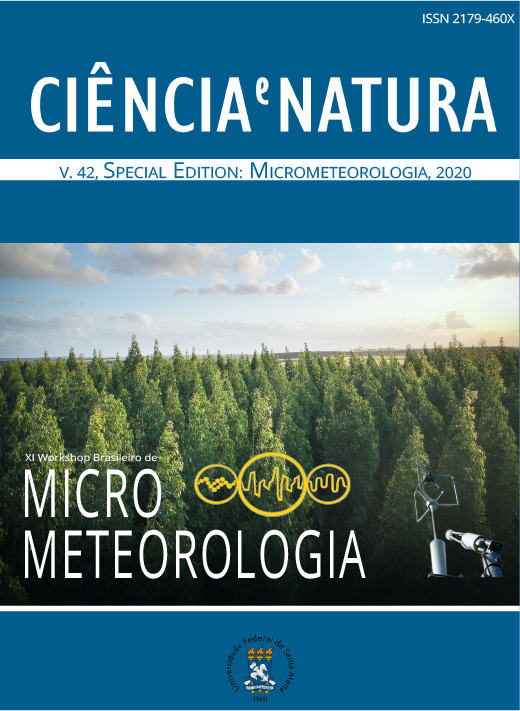Analysis of influence the use of cumulus parameterization in the wind simulation with different planetary boundary layer parameterizations
DOI:
https://doi.org/10.5902/2179460X53216Keywords:
Wind, Parametrization, Planetary boundary layerAbstract
The present work aimed to evaluate the influence of use the cumulus parameterization on the wind shift with two dynamic planetary boundary layer parameterizations using the Weather Research and Forecast model. Studies on model simulations using PBL parameterizations in tropical regions are generally rare, mainly due to the lack of experimental observations. This work is part of a project developed in partnership between
TPP Pecém II, TPP Parnaíba I, Parnaíba II and III generation of S.A. Energy and the Federal University of Santa Maria-UFSM. The Parnaíba Thermoelectric Power Plant (UTE) complex is located in Santo Antônio dos Lopes city in Maranhão and is operated by the Brazilian company Eneva. As energy production through the combustion of natural gas produces wastes that are released into the atmosphere, environmental regulatory bodies demand that verification and control measures be taken, such as chemical species monitoring. Therefore, a good description of the atmosphere is fundamental for the good performance of chemical species dispersion models. Four automatic weather stations were used to validate the model simulations. The model had difficulty reproducing the wind magnitude values as observed.
Downloads
References
GRELL, G. A.; FREITAS, S. R. et al. A scale and aerosol aware stochastic convective parameterization for weather and air quality modeling. Atmos. Chem. Phys, v. 14, n. 10, p. 5233–5250, 2014.
HONG, S.-Y.; DUDHIA, J.; CHEN, S.-H. A revised approach to ice microphysical processes for the bulk parameterization of clouds and precipitation. Monthly Weather Review, v. 132, n. 1, p. 103–120, 2004.
HONG, S.-Y.; PAN, H.-L. Nonlocal boundary layer vertical diffusion in a medium-range forecast model. Monthly weather review, v. 124, n. 10, p. 2322–2339, 1996.
MOLION, L. C. B.; BERNARDO, S. O. Uma revisão da dinâmica das chuvas no nordeste brasileiro. Revista Brasileira de Meteorologia, v. 17, n. 1, p. 1–10, 2002.
NAKANISHI, M.; NIINO, H. An improved mellor–yamada level-3 model with condensation physics: Its design and verification. Boundary-layer meteorology, Springer, v. 112, n. 1, p. 1–31, 2004.
PINTO, L. Avaliação do modelo WRF para aplicação em previsão de recursos eólicos no nordeste brasileiro. 2017. Tese (Doutorado) — Tese de Doutorado. Curso de Pós-Graduação em Ciência do Sistema Terrestre . . . , 2017.
SILVA, A. F.; FISCH, G. Avaliação do modelo wrf para a previsão do perfil do vento no centro de lançamento de alcântara. Revista Brasileira de Meteorologia, SciELO Brasil, v. 29, n. 2, p. 259- 270, 2014.
STULL, R. An introduction to boundary layer meteorology. Dordrecht: Kluwer Academic Publishers, 1988. 666 p.
WILKS, D. Statistical Methods in the Atmospheric Sciences. 2ª edição. San Diego: Academic Press, 2006. 648 p.
Downloads
Published
How to Cite
Issue
Section
License
To access the DECLARATION AND TRANSFER OF COPYRIGHT AUTHOR’S DECLARATION AND COPYRIGHT LICENSE click here.
Ethical Guidelines for Journal Publication
The Ciência e Natura journal is committed to ensuring ethics in publication and quality of articles.
Conformance to standards of ethical behavior is therefore expected of all parties involved: Authors, Editors, Reviewers, and the Publisher.
In particular,
Authors: Authors should present an objective discussion of the significance of research work as well as sufficient detail and references to permit others to replicate the experiments. Fraudulent or knowingly inaccurate statements constitute unethical behavior and are unacceptable. Review Articles should also be objective, comprehensive, and accurate accounts of the state of the art. The Authors should ensure that their work is entirely original works, and if the work and/or words of others have been used, this has been appropriately acknowledged. Plagiarism in all its forms constitutes unethical publishing behavior and is unacceptable. Submitting the same manuscript to more than one journal concurrently constitutes unethical publishing behavior and is unacceptable. Authors should not submit articles describing essentially the same research to more than one journal. The corresponding Author should ensure that there is a full consensus of all Co-authors in approving the final version of the paper and its submission for publication.
Editors: Editors should evaluate manuscripts exclusively on the basis of their academic merit. An Editor must not use unpublished information in the editor's own research without the express written consent of the Author. Editors should take reasonable responsive measures when ethical complaints have been presented concerning a submitted manuscript or published paper.
Reviewers: Any manuscripts received for review must be treated as confidential documents. Privileged information or ideas obtained through peer review must be kept confidential and not used for personal advantage. Reviewers should be conducted objectively, and observations should be formulated clearly with supporting arguments, so that Authors can use them for improving the paper. Any selected Reviewer who feels unqualified to review the research reported in a manuscript or knows that its prompt review will be impossible should notify the Editor and excuse himself from the review process. Reviewers should not consider manuscripts in which they have conflicts of interest resulting from competitive, collaborative, or other relationships or connections with any of the authors, companies, or institutions connected to the papers.






